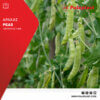
- Spinach, scientifically named Spinacia oleracea and classified under the Chenopodiaceae family, is a popular leafy vegetable with high nutritional value, rich in vitamins A, C, and K, as well as iron and magnesium. It is an annual herbaceous plant originally from Asia, now primarily cultivated in Europe and North America.
- Spinach is a cool-season crop thriving in areas with an average temperature of 16 – 18°C, though it can also grow well at lower temperatures near 10°C. Young plants can withstand frost temperatures down to -9°C without significant damage. The optimal soil temperature for seed germination ranges from 10 – 15°C, while seeds enter dormancy above 30°C, making germination difficult or nearly impossible in high temperatures.
- Spinach prefers well-drained soils with high organic matter content and a pH ranging from 6.0 to 7.5. It requires adequate sunlight but can tolerate partial shade. Sowing is done directly in the soil, placing seeds at a depth of about 1–2 cm and spacing rows 15–30 cm apart.
- Spinach is widely grown for its high nutritional value and contribution to overall health and wellness.
Its key health benefits include:
- Immune Support: Rich in vitamins A and C.
- Bone Health: High in vitamin K and calcium, supporting bone structure.
- Heart Health: Potassium and magnesium help maintain healthy blood pressure.
- Anti-inflammatory Effects: Antioxidants reduce inflammation and protect cells.
- Digestive Health: Dietary fiber improves digestion and supports gut health.
SPINACH IRRIGATION
Which are the water requirements of spinach?
Irrigation is a critical factor for spinach cultivation, influencing plant growth, leaf quality, and crop yield. Spinach requires consistent moisture for proper growth, but excessive water can lead to diseases such as root rot.
- Guidance for Optimal Spinach Irrigation
- Frequency: Regular watering is necessary, especially during growth periods. Both drought and overwatering should be avoided.
- Water Quality: Spinach is sensitive to high salinity levels, so using good-quality water is recommended.
- Moisture Control: Soil should remain moist but not waterlogged. Using moisture sensors can help monitor soil conditions effectively.
Which is the most appropriate of the irrigation systems applied to the cultivation of spinach?
The main irrigation systems used in the cultivation of spinach are the following:
- Drip Irrigation
Drip irrigation is a highly efficient method for spinach cultivation. Water is delivered directly to the plant roots, providing precise moisture levels. This system minimizes water consumption, reduces evaporation, prevents disease spread by keeping leaves dry, and allows adjustments to plant needs.
- Sprinkler Irrigation
Sprinkler systems distribute water as rain over the crop. This method is suitable for small to medium-sized crops and ensures uniform water coverage. It can cool plants during high temperatures but requires caution to avoid overwatering, which may increase disease risks due to leaf moisture.
- Surface Irrigation
A traditional method where water flows through furrows or strips between crop rows. While not the most efficient for spinach, it can be useful in areas with abundant water. Proper management of furrows is essential to ensure even water distribution and good drainage to avoid stagnant water that can cause root rot.
Palaplast has a wide range of products that can be used to install a reliable and efficient drip irrigation system or irrigation with micro-sprinklers system for spinach cultivation:
- Irrigation pipes AGROPAL HDPE 80 και LDPE
- Pressure Compensating Driplines, Driplines (Paladrip – Palaplast, Paladrip-XL – Palaplast, Paladrip-Slim – Palaplast)
- Dripline fittings
- Clamp saddles
- Filters
- Micro-sprinklers


